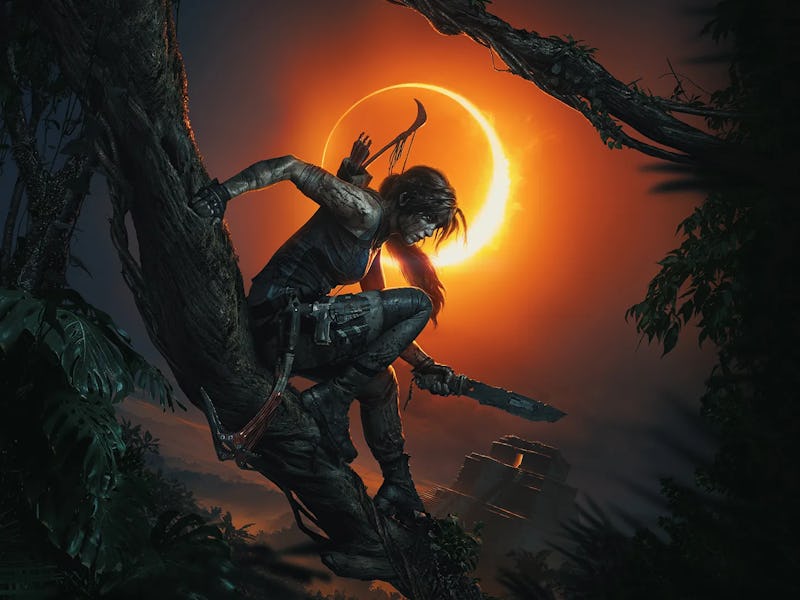The Original Tomb Raider Still Embodies the Best (and Worst) of Gaming
It belongs in a museum.

Tomb Raider wasn’t the first game with a female protagonist, nor is it the best one. There hasn’t been a new main series game since 2018’s Shadow of the Tomb Raider, and plenty of the franchise’s titles are forgettable at best. Still, Tomb Raider is one of the most recognizable video game series around, thanks in large part to its iconic star.
The origin of Lara Croft has been enshrined in countless interviews with Tomb Raider’s creators over the years. As the story goes, Tomb Raider began as an action game modeled after the Indiana Jones films with a male lead who bore a bit too much resemblance to that series’ whip-cracking hero. Developer Toby Gard designed his replacement, an adventurous woman inspired by Tank Girl and musician Neneh Cherry, according to The New York Times.
There’s a thin line between empowerment and sexualization with Lara Croft.
From the start, Lara Croft was full of contradictions. In 1996, video games were seen as an overwhelmingly male medium, both in who played them and who was portrayed on screen. The simple fact that Tomb Raider’s star was a woman was enough to garner attention, and her portrayal as being smart and capable — far from the damsels in distress that female characters were often shown as — made her an icon overnight.
At the same time, Croft’s design immediately drew backlash for being sexist. Her wildly unrealistic proportions were called out as playing to male fantasies, as was the frankly impractical decision to outfit her in short shorts to go rummaging around in ancient tombs. While she may have been designed to be a hero, it’s no accident that she also became a bombshell icon.
"She was just meant to be curvy and attractive,” level designer Neal Boyd told Eurogamer in 2019. “Toby said, if you're going to be following behind her, she might as well be appealing to look at.”
Tomb Raider’s marketing may have played an even bigger role in sexualizing Croft than its designers. Ads for the game played up Croft’s physical appeal, turning her into something of a joke, which eventually drove even her original designer, Gard, to leave Core Design, Eurogamer and others have reported.
Even Croft’s name epitomizes the contradiction at the heart of Tomb Raider. Originally, she was Lara Cruz, a South American explorer, but management at Eidos, which owned Core Design, reportedly demanded the change to appeal to an implicitly white U.K. audience, IGN reported.
Recent games tackle Tomb Raider’s colonialist themes — with mixed results.
Just as it’s something of a Rorschach test for how viewers feel about Croft, the series’ core message is just as conflicted. You don’t have to read too deeply to find something objectionable about a white British woman delving into ancient tombs and stealing artifacts from other cultures. The first Tomb Raider series sidestepped all of that complexity, using tombs and their contents as little more than vessels for puzzles. When there was conflict, it was mostly with animals (including, perplexingly, dinosaurs) and supernatural creatures.
Recent reboots have tried to better grapple with Croft’s place in the world, for better or worse. It’s most evident in Shadow of the Tomb Raider, where the destruction of colonialism is directly addressed. Croft expresses remorse for her role in despoiling and even destroying cultures that aren’t her own. But ultimately, she’s still got to raid those tombs.
Tomb Raider is as much a symbol as it is a game at this point. With the series’ future now uncertain (aside from a planned collection of remasters), Tomb Raider has become an artifact from another time. The games industry in 1996 was even less interested in tackling its relationship with sexism and colonialism than it is now, and those conversations took a much different shape across all of mainstream culture.
The original Tomb Raider games are weirder than most people remember.
Lara Croft was once a lightning rod, serving as both a source of empowerment for young women who loved Tomb Raider and an exemplar of a medium that accepted and reinforced sexist tropes. Now, her original design evokes little more than snickering and perhaps nostalgia.
The original Tomb Raider came at a time when an explorer with a ludicrous body shape could plunder cultural relics with all the gusto of the British Museum and hardly raise any eyebrows. It’s not that some AAA games don’t treat their subject matter thoughtlessly even now, but that we as players expect more than fun. And to be fair, Tomb Raider was fun — that’s why it caught on! But what’s more interesting is how its series became intertwined first with growing mainstream feminism in the ’90s, then later in conversations about appropriation and exploitation.
Maybe it’s better that the Tomb Raider series remains in the past, but it will always be a fascinating emblem of a growing medium.